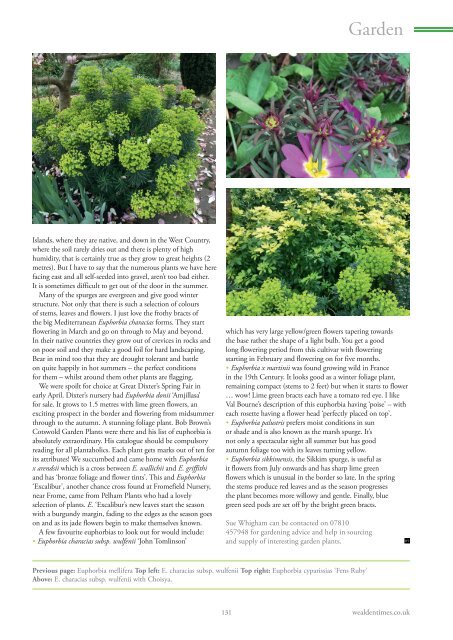Wealden Times | WT207 | May 2019 | Extensions & Outdoor Living supplement inside
Wealden Times - The lifestyle magazine for the Weald
Wealden Times - The lifestyle magazine for the Weald
Create successful ePaper yourself
Turn your PDF publications into a flip-book with our unique Google optimized e-Paper software.
Garden<br />
Islands, where they are native, and down in the West Country,<br />
where the soil rarely dries out and there is plenty of high<br />
humidity, that is certainly true as they grow to great heights (2<br />
metres). But I have to say that the numerous plants we have here<br />
facing east and all self-seeded into gravel, aren’t too bad either.<br />
It is sometimes difficult to get out of the door in the summer.<br />
Many of the spurges are evergreen and give good winter<br />
structure. Not only that there is such a selection of colours<br />
of stems, leaves and flowers. I just love the frothy bracts of<br />
the big Mediterranean Euphorbia characias forms. They start<br />
flowering in March and go on through to <strong>May</strong> and beyond.<br />
In their native countries they grow out of crevices in rocks and<br />
on poor soil and they make a good foil for hard landscaping.<br />
Bear in mind too that they are drought tolerant and battle<br />
on quite happily in hot summers – the perfect conditions<br />
for them – whilst around them other plants are flagging.<br />
We were spoilt for choice at Great Dixter’s Spring Fair in<br />
early April. Dixter’s nursery had Euphorbia donii ‘Amjillasa’<br />
for sale. It grows to 1.5 metres with lime green flowers, an<br />
exciting prospect in the border and flowering from midsummer<br />
through to the autumn. A stunning foliage plant. Bob Brown’s<br />
Cotswold Garden Plants were there and his list of euphorbia is<br />
absolutely extraordinary. His catalogue should be compulsory<br />
reading for all plantaholics. Each plant gets marks out of ten for<br />
its attributes! We succumbed and came home with Euphorbia<br />
x arendsii which is a cross between E. wallichii and E. griffithi<br />
and has ‘bronze foliage and flower tints’. This and Euphorbia<br />
‘Excalibur’, another chance cross found at Fromefield Nursery,<br />
near Frome, came from Pelham Plants who had a lovely<br />
selection of plants. E. ‘Excalibur’s new leaves start the season<br />
with a burgundy margin, fading to the edges as the season goes<br />
on and as its jade flowers begin to make themselves known.<br />
A few favourite euphorbias to look out for would include:<br />
• Euphorbia characias subsp. wulfenii ‘John Tomlinson’<br />
which has very large yellow/green flowers tapering towards<br />
the base rather the shape of a light bulb. You get a good<br />
long flowering period from this cultivar with flowering<br />
starting in February and flowering on for five months.<br />
• Euphorbia x martinii was found growing wild in France<br />
in the 19th Century. It looks good as a winter foliage plant,<br />
remaining compact (stems to 2 feet) but when it starts to flower<br />
… wow! Lime green bracts each have a tomato red eye. I like<br />
Val Bourne’s description of this euphorbia having ‘poise’ – with<br />
each rosette having a flower head ‘perfectly placed on top’.<br />
• Euphorbia palustris prefers moist conditions in sun<br />
or shade and is also known as the marsh spurge. It’s<br />
not only a spectacular sight all summer but has good<br />
autumn foliage too with its leaves turning yellow.<br />
• Euphorbia sikkimensis, the Sikkim spurge, is useful as<br />
it flowers from July onwards and has sharp lime green<br />
flowers which is unusual in the border so late. In the spring<br />
the stems produce red leaves and as the season progresses<br />
the plant becomes more willowy and gentle. Finally, blue<br />
green seed pods are set off by the bright green bracts.<br />
Sue Whigham can be contacted on 07810<br />
457948 for gardening advice and help in sourcing<br />
and supply of interesting garden plants.<br />
Previous page: Euphorbia mellifera Top left: E. characias subsp. wulfenii Top right: Euphorbia cyparissias ‘Fens Ruby’<br />
Above: E. characias subsp. wulfenii with Choisya.<br />
131 wealdentimes.co.uk


















